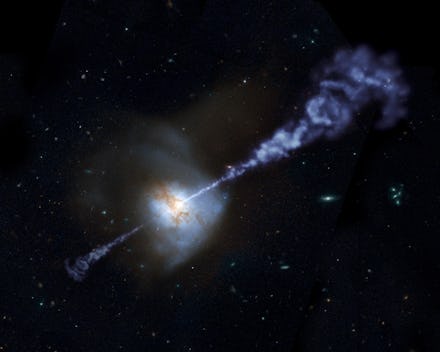Scientists Figured Out What Causes Super-Bright Black Hole Jets to Burst Through Galaxies

Supermassive black holes, the kind that sit at the center of most galaxies, sometimes shoot out streams of hot, ionized gas that get twisted and propelled by magnetic fields. These jets are so bright, they're often visible far across the universe from where they erupt.
Black hole jets are hard to predict, though. Sometimes they shoot out and rip through the galaxy and out into intergalactic space, but other times they sputter and fizzle out.
Now, a team of astronomers have simulated black hole jets, and they might have an explanation for why some get snuffed out.
The research could help us figure out how galaxies form around black holes.
The astronomers realized that the fates of the jets are probably tied to the magnetic fields around the black hole. Jets with more stable magnetic fields are broader and have enough power to burst beyond the edges of the galaxy. If the magnetic fields inside the jets aren't stable, then the streams of gas narrow and eventually break, spilling a bubble of hot gas into the galaxy.
"If I were to jump on top of a jet and fly with it, I would see the jet start to wiggle around because of a kink instability in the magnetic field," theoretical astrophysicist Alexander Tchekhovskoy said in a University of California, Berkeley, news release. "If this wiggling grows faster than it takes the gas to reach the tip, then the jet will fall apart. If the instability grows slower than it takes for gas to go from the base to the tip of the jet, then the jet will stay stable."
Collapsed black hole jets heat up the whole galaxy. When that happens, the temperature spike stops more gas from falling into the black hole and essentially stunts its growth. So it seems collapsed jets help keep the size of supermassive black holes in check. More research may help us understand how jets influence the overall size of galaxies as well.
Read more: